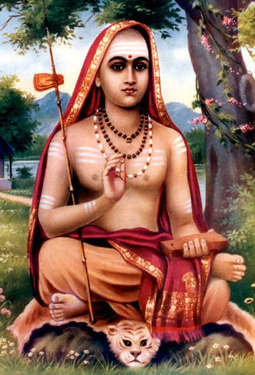VIVEKACŪḌĀMAṆI
Introduction

Vivekacūḍāmaṇi, The Crown Jewel of Discrimination is the work of the sage Ādi Śaṅkara, also known as Śaṅkarācārya, Śaṅkara the Teacher. Śaṅkara lived in the eighth century of the common era and is famous for establishing the Advaita Vedānta philosophy in India.
Śaṅkara was a prolific writer whose works can be divided into three categories: Bhāṣya – commentaries of the Brahma Sūtra, Bhagavad Gītā, and Principal Upaniṣads; Prakaraṇa Granthas – philosophical expositions; and Stotras – poems and devotional hymns. Like the works they are based on, the commentaries are extensive. They are not only meant to explain the scriptural text, but also to define the philosophy and establish its scriptural basis. They are intended for advanced study by philosophers and scholars. The Prakaraṇa, on the other hand, are shorter works intended to explain specific philosophical concepts. They are meant to prepare students for advanced study and are written for the general public.
The Vivekacūḍāmaṇi is one of the most extensive of Śaṅkara’s philosophical treatises. It covers the principles of Advaita Vedānta, as well Yoga practice. The key points of the Vivekacūḍāmaṇi are as follows:
Śaṅkara was a prolific writer whose works can be divided into three categories: Bhāṣya – commentaries of the Brahma Sūtra, Bhagavad Gītā, and Principal Upaniṣads; Prakaraṇa Granthas – philosophical expositions; and Stotras – poems and devotional hymns. Like the works they are based on, the commentaries are extensive. They are not only meant to explain the scriptural text, but also to define the philosophy and establish its scriptural basis. They are intended for advanced study by philosophers and scholars. The Prakaraṇa, on the other hand, are shorter works intended to explain specific philosophical concepts. They are meant to prepare students for advanced study and are written for the general public.
The Vivekacūḍāmaṇi is one of the most extensive of Śaṅkara’s philosophical treatises. It covers the principles of Advaita Vedānta, as well Yoga practice. The key points of the Vivekacūḍāmaṇi are as follows:
- The goal of human life is to realize one’s True Self.
- Discrimination of Self and non-self is the means to liberation from the bondage of transmigratory, mundane existence (saṁsāra).
- One must overcome the desire for sense objects.
- The three bodies and five sheaths are all non-self.
- The ego, by identifying non-self as self, is the cause of bondage.
- Direct experience of one’s True Self leads to liberation, not scriptural study or religious actions.
- The Self is experienced in samādhi.
- Non-self is an adjunct, superimposed on the Self due to illusion, the way one mistakes a rope for a snake in the dark.
- One must overcome both the veiling and projecting powers of Māyā. The veiling power hides the Self and the projecting power manifests the illusion of a manifold universe.
- By the constant practice of meditation, one purifies the mind and overcomes illusion.
- The subliminal impressions of worldly thoughts and actions (vāsanās) are overcome by the subliminal impressions of samādhi.
- Brahman and the Self are one.
- The one who realizes their True Self attains everlasting bliss and is never born again, becoming one with Brahman at the end of this life.
Go to Vivekacūḍāmaṇi

